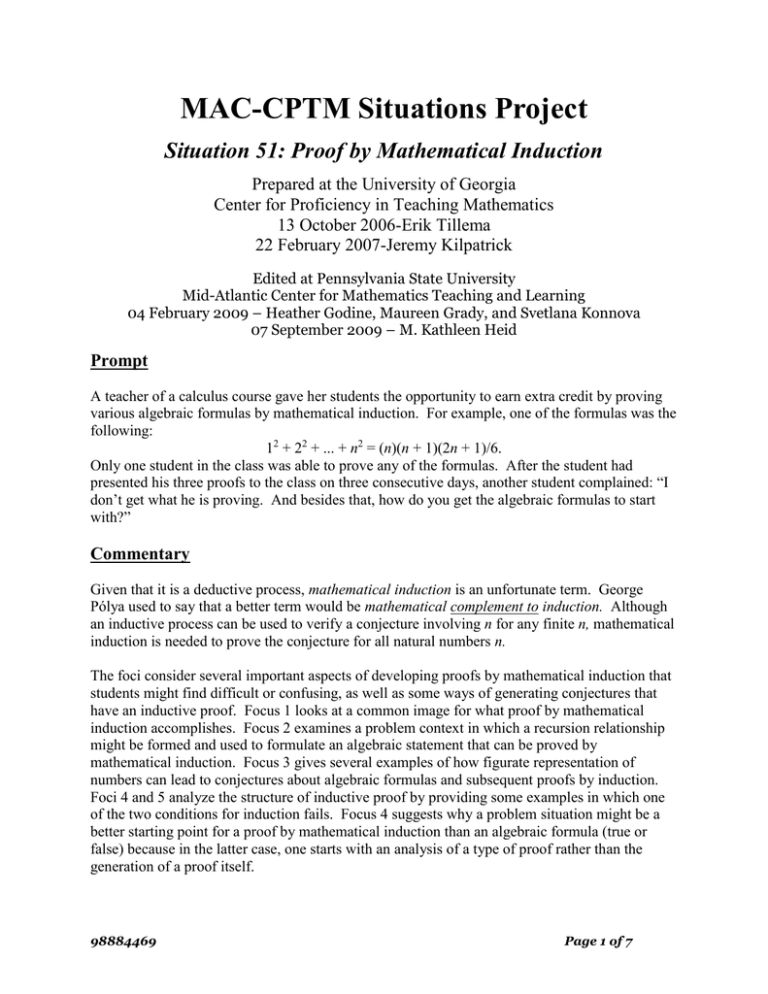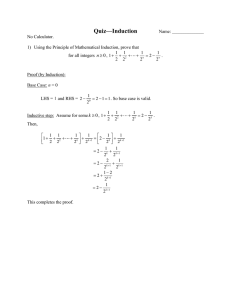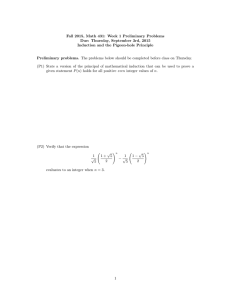MAC-CPTM Situations Project Situation 51: Proof by Mathematical Induction
advertisement

MAC-CPTM Situations Project
Situation 51: Proof by Mathematical Induction
Prepared at the University of Georgia
Center for Proficiency in Teaching Mathematics
13 October 2006-Erik Tillema
22 February 2007-Jeremy Kilpatrick
Edited at Pennsylvania State University
Mid-Atlantic Center for Mathematics Teaching and Learning
04 February 2009 – Heather Godine, Maureen Grady, and Svetlana Konnova
07 September 2009 – M. Kathleen Heid
Prompt
A teacher of a calculus course gave her students the opportunity to earn extra credit by proving
various algebraic formulas by mathematical induction. For example, one of the formulas was the
following:
12 + 22 + ... + n2 = (n)(n + 1)(2n + 1)/6.
Only one student in the class was able to prove any of the formulas. After the student had
presented his three proofs to the class on three consecutive days, another student complained: “I
don’t get what he is proving. And besides that, how do you get the algebraic formulas to start
with?”
Commentary
Given that it is a deductive process, mathematical induction is an unfortunate term. George
Pólya used to say that a better term would be mathematical complement to induction. Although
an inductive process can be used to verify a conjecture involving n for any finite n, mathematical
induction is needed to prove the conjecture for all natural numbers n.
The foci consider several important aspects of developing proofs by mathematical induction that
students might find difficult or confusing, as well as some ways of generating conjectures that
have an inductive proof. Focus 1 looks at a common image for what proof by mathematical
induction accomplishes. Focus 2 examines a problem context in which a recursion relationship
might be formed and used to formulate an algebraic statement that can be proved by
mathematical induction. Focus 3 gives several examples of how figurate representation of
numbers can lead to conjectures about algebraic formulas and subsequent proofs by induction.
Foci 4 and 5 analyze the structure of inductive proof by providing some examples in which one
of the two conditions for induction fails. Focus 4 suggests why a problem situation might be a
better starting point for a proof by mathematical induction than an algebraic formula (true or
false) because in the latter case, one starts with an analysis of a type of proof rather than the
generation of a proof itself.
98884469
Page 1 of 7
Mathematical Foci
Mathematical Focus 1
Proof by mathematical induction can be portrayed with an image of any process involving a
basis (k = 0) and an inductive step (if the conjecture holds for n = k, it holds for n = k + 1).
It may be useful to provide some images of what mathematical induction does. One good image
might be of a ladder that is infinitely tall (with the rungs representing the set of positive integers).
In doing a proof by induction, we first have to check whether we can get on the first rung of the
ladder (which corresponds to checking whether the base case of the proposition holds true).
Once we know we can get on the ladder, we have to check that if we are on any step of the
ladder, we can proceed to the next one; namely, if we are on the kth rung, we can move to the
(k + 1)st rung (which corresponds to showing that if the proposition holds for k it will hold for
k + 1). By proving these two things, we claim that, using the principle of mathematical
induction, we can get to any rung of the ladder (which corresponds to proving that the
proposition is true for all k).
An alternate image used to illustrate proof by mathematical induction involves the domino effect.
Imagine an infinite row of dominoes standing on end. If one knows that the first domino will
fall, and if one knows that when domino k falls, its next neighbor (k + 1) will fall, then by the
principle of mathematical induction, all the dominos will fall.
Mathematical Focus 2
Proof by mathematical induction can be motivated by a recursion relationship using a graphic
display.
Many recursion formulas create problem-solving opportunities that might lead to an algebraic
formulation of a situation and a subsequent proof by mathematical induction. One such problem
situation1 is the following:
Suppose you have a 2n 2n chessboard. Show that if you remove one square (shown in black,)
you can cover the remaining squares on the board with L-triominoes (shown in purple).
This problem situation arose in Patricia Wilson’s EMAT 6650 (Historical and Cultural
Foundations of Mathematics) course.
1
98884469
Page 2 of 7
In the case shown above, there is an 8 8 chessboard. It is easy to show that it is possible to find
a covering of the chessboard, but it is a little difficult to see a pattern in a particular covering of a
chessboard of this size. This difficulty provides a good opportunity to use Polya’s heuristic
strategy of looking at a related problem that is simpler. Let’s examine a 2 2 and 4 4
chessboard. In the 2 2 case, we can clearly cover the chessboard without any difficulty. That
is, we can place a triomino as we please, and exactly one space will be left over:
We might next look at a 4 4 board and notice that it is composed of exactly four 2 2
chessboards (and further that there are four 4 4 chessboards in an 8 8 chessboard). In making
this observation, we can establish a recursion relationship between successive chessboards.
Also, we might observe that our 4 4 board will have exactly one 2 2 chessboard with the
space taken out of it and three 2 2 chessboards with exactly one space not covered. We can
cover those three spaces with exactly one triomino (shown on the left).
Having made these observations, we can set up a recursion relationship between successive
boards and make a more formal proof by mathematical induction. Note that in this case we
might simply do the proof by writing out our observations.
On the other hand, we might use this problem to show that (22n 1)/3 is a whole number for all
n > 1. To think of this algebraic formulation, we notice that the chessboard contains 22n squares
and that removing one of the squares gives us 22n 1 remaining squares to be covered. Also,
each triomino contains 3 squares. Most importantly, we have to see that the spatial arrangement
of the triominoes on the board does not affect the solution of the problem. Imagine cutting the
board at each row and putting the rows end to end. Then imagine changing the L-triominoes to
straight triominoes (shown below for the 4 4 chessboard).
98884469
Page 3 of 7
We can once again use a recursive argument to show that we can cover all but one of the squares
of our transformed board with our transformed triominoes. From this spatial configuration, we
may become more convinced that we are asking ourselves a question of division. That is, how
many threes are in a row of length 22n 1? The answer is a whole number.
Mathematical Focus 3
Figurate numbers can also be used to generate identities that can then be proved by
mathematical induction.
Consider a figurate representation for the square numbers using dots. In that configuration, one
might observe the pattern below:
The configuration suggests that n2 = 1 + 3 + … + (2n 1). Having made a conjecture about the
formula, we can then try to prove it by mathematical induction. (Also, how might a formula for
the sum of the first n even numbers be found and proved?)
A second situation that uses figurate numbers and that extends Situation 39, which demonstrates
n(n 1)
several ways to get an intuitive feeling for why the sum of the first n integers equals
, is
2
to find the sum of the first n sums of the first n integers. Algebraically, if T1 = 1, T2 = 1 + 2, …
Tn = 1 + 2 + … + n, then we want to find T1 + T2 + … + Tn. We can introduce the situation by
finding both an additive and multiplicative solution to the following problem. Suppose there are
five points on a circle. How many possible triangles can you make?
We can structure the problem additively by thinking about the number of triangles with AB as
the base (3), with BC as the base (2 more), and with CD as the base (1 more), or T1 T2 T3 .
98884469
Page 4 of 7
5
Multiplicatively, we can think about choosing sets of three points from five or . After solving
3
the problem for several numbers of points, we might conjecture that
n 2 1
T1 T2 ... Tn
(n 2)(n 1)(n) , and use the problem context to prove the identity
3 6
by mathematical induction. (An extension of the problem would be to find an additive and
multiplicative way of thinking about the number of diagonals that can be drawn in a convex ngon).
We might then consider using the identity to find an identity for 12 2 2 ... n 2. We again make
a figurate representation of the problem to help us see what the identity might be. The first four
square numbers are shown below:
Knowing that we have a formula for the sum of the first n triangular numbers, we break the
figure into triangular numbers:
From our example of the sum of the first four square numbers, we might observe that the sum of
n 2 n 1
the first n square numbers is 2T1 2T2 .... 2Tn1 Tn
. A little algebraic
3 3
manipulation gives 12 22 ...n 2 16 (2n 1)(n 1)(n) , another formula that we conjecture to be
true and whose validity might be established by mathematical induction.
A final problem might be to look at the square of the sum of the first n integers: (1 + 2 +…+ n)2.
We again
might want to make a figurate representation of the case for n = 4:
98884469
Page 5 of 7
5
How many groups of four are in the figure above? There are vertical groups (the sum of the
2
4
first four integers), and there are horizontal groups (the sum of the first three integers),
2
5 4
4
giving a total of 2 2 dots. A little algebraic simplification shows that there are 43
of the figure. A similar process shows us that in computing the dots
dots in the outermost region
in groups of threes gives us 33 dots, and so on. That yields a conjecture for the following
identity: (1 + 2 +…n)2 = 13 + 23 +… + n3. We then can prove the formula by mathematical
induction.
Mathematical Focus 4
Proof by mathematical induction requires both a basis step and an inductive step; it fails if either
is lacking.
Many of the examples in which one of the steps fails are somewhat trivial, but they can
nonetheless give us some feeling for the importance of both.
For instance, consider the inequality 5(2 n ) 6n . It holds true for n =1 (we can get on the
ladder). Now assume the inequality is true for n = k and try to show that it is true for n = k + 1.
We need to show that 5(2k 1) 6k 1 given that 5(2k ) 6k . We use the inductive hypothesis to
form the inequality 5(2k 1) 2(5(2k ) 2(6k ) , and we would like to be able to conclude that
2(6k ) 6(6k ) 6k 1. However, that would imply that 2 > 6, which is false. Seeing no way to
proceed, we
check our assumption.
If n = 2, 5(2 n ) 6n yields 20 > 36, which is false. In this
case, we were able to get on the first step of the ladder but not able to move from rung to rung.
We might now consider the inequality 3n 5(3n ) . Suppose we begin by assuming that it is true
for n = k and try to prove it for n = k + 1. We find that 3k 1 3(3k ) 3(5(3k ) 5(3k 1), and the
inequality holds true based on our inductive hypothesis (we are able to move from rung to rung).
However, in the case of n = 1 the inequality does not hold. We are unable to get on the ladder
98884469
Page 6 of 7
even though if we could, we could move from rung to rung. These examples illustrate that both
conditions need to be met in for a proof by mathematical induction to work. They also suggest
that it is worth checking several cases when proving something by induction.
Checking several cases, however, is not a substitute for a proof, as can be seen by the inequality
3n n!. This inequality holds for the first six cases, but it is false when n = 7. For any a, the
inequality a n n! will eventually become false even though we can make the n for which it
becomes false arbitrarily large. This example demonstrates that proof by mathematical induction
is in fact deductive. That is, we are not drawing a conclusion based solely on repeated
observations (inductive reasoning), instead, we are establishing two premises and stating that if
both premises hold true we can assert the conclusion (deductive reasoning). The three examples
in this focus taken together suggest the relationship of the premises to the conclusion as well as
the role that observation plays in relation to a proof by induction.
Mathematical Focus 5
Proof by mathematical induction requires one to consider the basis step, depending on the
nature of the operations involved.
In case we wish to prove a statement defined from a binary operation, then the basis step has to
contain the n = 2 case. An example of a binary operation could be an operation that includes an
equivalence relation.
In the middle of the 20th century, George Pólya posed the following exercise: Find the error in
the following argument, which proposes to prove that all horses are of the same color using the
method of mathematical induction.
* Basis: If there is only one horse, there is only one color.
* Induction step: Assume as induction hypothesis that within any set of n horses, there is only
one color. Now look at any set of n + 1 horses. Number them: 1, 2, 3, ... , n, n + 1. Consider the
sets {1, 2, 3, ... , n} and {2, 3, 4, ... , n + 1}. Each is a set of only n horses; therefore within each
there is only one color. But the two sets overlap, so there must be only one color among all n + 1
horses.
Let us analyze the use of the method of mathematical induction for the example given above.
For the basis step, the n = 1 case is trivial because any horse is the same color as itself. However,
the logic of the inductive step is incorrect when n = 2. In case n = 2 we have to consider two sets
{1} and {2} and they do not overlap. Therefore, even thought the inductive step is correct in all
cases when n > 2, the logic of the inductive step is incorrect when n = 2. Consequently, the
method of mathematical induction cannot be applied to prove that that all horses are of the same
color, because the basis step for this example, where the binary operation is involved has to
consider the n = 2 case and it fails.
98884469
Page 7 of 7






